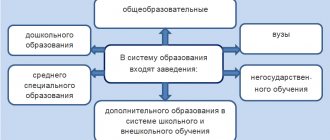The legislation regulates certain types of income of citizens, which are deducted from the total amount for taxation. Tax deductions are not subject to the usual personal income tax rate of 13% if they are standard.
Amounts deducted for children are standard tax deductions. This means that this form of reducing the tax burden will be in effect continuously as long as the original status of the taxpayer is maintained (in this case, receiving taxable income and the presence of one or more future heirs).
To whom can this deduction be made?
Article 218 of the Tax Code of the Russian Federation prescribes the procedure for assigning and calculating tax benefits, including “children’s” deductions. According to the law, the child tax deduction is an amount of money designated in regulations, from which the 13% personal income tax (income tax) will not be charged.
Each has the right to make this deduction :
- the child's natural parents;
- adoptive parents;
- guardians;
- trustees.
The right to receive this tax benefit is recognized if there are one or more offspring under the age of 18 or older (up to 24 years), if the eldest child is a full-time student as:
- student;
- cadet;
- intern;
- graduate student;
- resident.
FOR YOUR INFORMATION! Full-time education is allowed not only in an educational institution in the Russian Federation, but also abroad. Studying a master's degree as a first higher education will not be an obstacle to assigning a tax deduction (naturally, if the child meets the age criterion).
Regardless of age, a separate tax deduction will be accrued for disabled children.
“Children’s” deductions if children are from different marriages
The right to a standard “children’s” deduction arises provided that the child is supported by a parent. This clearly follows from Art. 218 Tax Code of the Russian Federation. In a standard situation, when a child lives with his parents, no questions arise. But can, for example, the father of a child claim a deduction if the parents divorced and the child lives with his mother after the divorce?
Yes, maybe, if he pays alimony to his ex-wife (letter of the Ministry of Finance of the Russian Federation dated October 11, 2012 No. 03-04-05/8-1179). In this case, such an employee, along with the usual package of documents, must submit to the accounting department documents confirming the payment of alimony (letter of the Ministry of Finance of the Russian Federation dated November 7, 2018 No. 03-04-05/80099).
But not only the father can count on a deduction in this case. His new wife can also receive a deduction for her husband's child from a previous marriage. After all, property acquired by spouses during marriage is their joint property (Article 256 of the Civil Code of the Russian Federation and Article 34 of the Family Code of the Russian Federation). Including money that must be paid in the form of child support. It turns out that the spouses of people who pay alimony also participate in the maintenance of these children. This means they are also entitled to standard deductions. This conclusion is contained in letters of the Ministry of Finance of the Russian Federation dated August 10, 2016 No. 03-04-05/46762, dated March 18, 2015 No. 03-04-05/14392 and the Federal Tax Service of the Russian Federation dated September 17, 2013 No. BS-4-11/16736.
If the employee does not pay alimony, then he still has the right to a deduction if he helps his ex-wife with money and can prove this. For example, documents proving the fact of transferring money to support the child, a written statement from the ex-wife (mother of the child) that the child’s father is involved in providing for him (letter of the Ministry of Finance of the Russian Federation dated 03.03.2016 No. 03-04-05/12376).
First, second, third... How much do we subtract?
The tax deduction is assigned separately for each child who meets the age criteria. For a child born first or second, it is the same amount, namely 1,400 rubles. If the taxpayer is in the care of three or more children or older children eligible for deduction, then for each offspring younger than the second, a deduction in the amount of 3,000 rubles will be charged. The amounts allocated for each of them are added up.
The number of children is counted according to seniority, that is, in the chronological order of their birth. In this case, the age of the older children and their status are not important. For example, the oldest is already over 18 and is not a full-time student, that is, he is not subject to a tax deduction, and there are only three children in the family. In this case, the youngest, who has not reached this age, is still the third child, who is entitled to a deduction in a larger amount - 3,000 rubles.
IMPORTANT! In tragic cases of death of children, their number according to seniority does not change: every living child still continues to be considered the same in number as he was at the moment of birth. If spouses have new children in another marriage, they will no longer be considered the first: the chronological order of birth is preserved.
A disabled child has the right to make a deduction within the following limits:
- 12,000 for each of the parents (natural or adopted);
- 6,000 (for guardians and trustees).
NOTE! The amounts given are not the money that will be returned to the taxpayer with children. These funds simply will not be charged the additional 13% due to personal income tax. For example, a citizen with two minor children will receive a tax benefit (1400 + 1400) x 0.13 = 364 rubles. This amount will make his tax burden lighter.
Users of the official website of the Federal Tax Service have the opportunity to independently calculate tax deductions using the online service. To calculate, you will need to enter the initial data in special fields:
- amount of children;
- the amount of taxable income for the previous period;
- data regarding children with disabilities.
Examples
In conclusion, here are some illustrative examples of the use of standard tax deductions.
Example 1
Citizen Krasnov I.A. is a liquidator of the consequences of the disaster at the Chernobyl nuclear power plant, in addition, he was awarded the Order of Glory, 3rd degree. He has a son aged 22 who is studying full-time. Krasnov I.A.’s monthly salary in 2021 is 65,000 rubles. What deductions can he expect?
He claims monthly deductions in the amount of 3,000 rubles. and 500 rubles, but according to current legislation these deductions do not add up, the maximum of them will be selected. Over the course of a year, this deduction will save Krasnov I.A. the amount of 4,680 rubles. (3,000 × 12 months × 13% = 4,680). As for the deduction for the child, since the son is a full-time student, Krasnov I.A. has the right to count on this deduction, however, it is worth noting that the deduction will no longer be provided as soon as Krasnov I.A.’s income exceeds 350,000 rubles. With the salary we indicated, this will happen in the 5th month. So, the amount of tax that Krasnov I.A. will save on his child’s education will be 728 rubles. (1,400 × 4 months × 13% = 728).
Let's summarize: Krasnov I.A. will save money in the amount of 5,408 rubles in 2021. (4 680 + 728).
Example 2
Ivanova A.A., due to the death of her husband, became the only parent for 3 children aged 25, 17 and 14 years. A. A. Ivanova’s monthly salary is 21,000 rubles. What deductions will she be entitled to?
The provision of a standard tax deduction for children in 2021 is limited to an income of 350,000 rubles. With her salary, Ivanova A.A. will be able to receive deductions throughout all 12 months of the year.
1st child aged 25 years - no deduction will be provided for him, however, he will be taken into account when counting children.
2nd child aged 17 years - the deduction for him will be 2,800 rubles. due to the fact that Ivanova A.A. is the only parent and has the right to receive a double deduction (1,400 × 2 = 2,800).
3rd child aged 14 years - the deduction for him will be 6,000 rubles, since starting from the 3rd child, the usual deduction is 3,000 rubles, and A. A. Ivanova has the right to double it as the only parent ( 3,000 × 2 = 6,000).
So, the amount of money saved by Ivanova A.A. will be: for the 2nd child - 4,368 rubles (12 months × 2,800 × 13% = 4,368), for the 3rd child - 9,360 rubles (12 months × 6,000 × 13% = 9,360).
The total amount of money saved by A. A. Ivanova for the year will be 13,728 rubles. (4,368 + 9,360).
ConsultantPlus experts reviewed even more examples with various nuances of providing a standard deduction for children. Learn the material by getting trial access to the system for free.
Double deduction amount
The law gives the right to certain categories of citizens to make a “children’s” tax deduction, doubled. If a child is being raised by a single mother, she has this right unconditionally (just like a father raising a child alone). Any parent can refuse to receive the child deduction due to him, then his share of this tax benefit will go to the other parent. If the child is adopted, then if one of the adoptive parents refuses the deduction, the other will receive it double.
When there is only one parent
There is no term “sole parent” in legislative acts. A single mother (less often a father) is considered the only parent by law if this is proven in the following documents:
- the second parent is not listed on the child’s birth certificate;
- The registry office issued a certificate (form 25) that information about the second parent was recorded in the certificate from the words of the first (most often the father is entered from the words of the mother);
- the second parent has died, for which there is official medical evidence;
- the second parent is officially deprived of parental rights;
- there is a court decision declaring the second parent dead or missing.
ATTENTION! An unregistered marriage cannot be grounds for recognizing a parent as single.
If a single parent registered a marriage, he will no longer be entitled to receive a double tax deduction, since he is no longer the sole caregiver of his child. But the new spouse automatically acquires the right to this benefit.
If you are remarried and have a child together
Often during remarriages, the question arises as to how a common child will be considered if there are children from previous marriages. Let's consider the situations.
Example:
Ivan’s first marriage has two adult children, for whom he does not return personal income tax. In the second marriage a child is born. What is the standard deduction for Ivan and his new wife Olga?
Letter of the Ministry of Finance of Russia dated June 7, 2013 N 03-04-05/21379 interprets a similar situation as follows: “In the situation under consideration, the parent’s spouse has the right to receive a standard tax deduction for the third child for each month of the tax period in the amount of 3,000 rubles. However, the standard tax deduction for the first and second adult children is not provided.”
In other words, Ivan receives 3,000 rubles for a common child, regardless of the age of the first children. Olga, as the parent’s spouse, also receives 3,000 rubles for their common baby.
Example:
Sergei and Svetlana have children from their first marriages. In their new marriage they have a common daughter. Sergei pays child support from his first marriage, raises Svetlana’s son and their common daughter. How much tax deduction is due to each spouse?
Sergey receives 1,400 rubles for a child from his first marriage, 1,400 rubles for Svetlana’s son and 3,000 for their common daughter. Total 5,800 rubles. Savings (5,800 x 13%) = 754 rubles. Svetlana receives 1,400 rubles for her son from her first marriage and 3,000 rubles for her common daughter, since, counting Sergei’s child from her first marriage, her common daughter is her third child.
Total 4,400 rubles. Savings (4,400 x 13%) = 572 rubles.
Thus, you need to add up the children of both parents and count from oldest to youngest. You will receive a standard deduction for those children who are in your care. At the same time, adult children are also taken into account in the queue, despite the fact that they are no longer entitled to a personal income tax refund.
Example:
Nikolai has three children, two of whom are adults. And although Nikolai and his wife no longer receive tax deductions for adult children, all children participate in determining the priority. The minor was born third, which means mom and dad receive 3,000 rubles for him.
Have a question or need to fill out 3-NDFL - we will help you!
To get a consultation
The limit set for income when calculating deductions
A large income removes from citizens the right to tax benefits for having children. If the amount of a citizen’s income exceeds that established by the state, he himself has the financial ability to be responsible for providing for the child, so there is no reason to reduce his tax burden. Until 2021, citizens who received more than 280 thousand rubles were not able to apply for a child tax deduction. In 2021, this amount was changed, and today it is 350 thousand rubles.
The time for which the income received is calculated begins to be taken into account from the beginning of the tax period, namely the calendar year. As soon as the accrual amount in a particular month has reached the legal limit, the deduction will no longer be accrued for subsequent months.
Documents for child tax deduction
If the child’s parents are officially employed, then their employer himself submits the necessary papers to the relevant tax authority. Citizens will simply receive wages in accordance with all taxes withheld and deductions made. The necessary documents are provided by employees to the human resources department or accounting department at their place of work.
For a standard “children’s” tax deduction you will need:
- birth or adoption certificates (for all children);
- an application in which the employee requests a standard tax deduction for the child(ren);
- certificate 2-NDFL for the previous year (if the place of work was changed);
- for children who are already 18 years old - a certificate stating that they are actually studying full-time at a particular educational institution (this certificate must be updated annually).
ADDITIONALLY! If the parents are divorced or their marriage has not been registered, then the second parent can receive a deduction if he documents that he is involved in providing for his offspring: for this he needs to provide an agreement on the payment of alimony or a certificate of registration at the same place of residence as the child. A court decision on determining the person with whom the child remains in the event of a parental divorce is also valid.
For a “double” deduction, the following is added to these documents:
- application for a double tax deduction;
- written refusal of the other parent or adoptive parent;
- Certificate 2-NDFL of the parent who wrote the refusal (for each month for which the deduction is made).
Deduction for the purchase of an apartment: documents, procedure for obtaining
Required documents:
- Identity card (passport of a citizen of the Russian Federation). If the tax return is submitted electronically, then an electronic signature (it can be easily obtained in your personal account on the website nalog.ru);
- Tax return in form 3-NDFL. The declaration template and instructions for filling out are available on the Federal Tax Service website;
- Application for tax refund. It can be drawn up when submitting a declaration to the tax office or taken a sample from the Federal Tax Service website. At the time of writing the application, you must choose a convenient option for returning a tax deduction - a one-time payment for the entire year, monthly payments or a reduction in the tax base in the future.
- Papers confirming the purchase of housing or expenses associated with it. This could be a purchase and sale agreement, an act of acceptance and transfer of premises, a loan agreement, a bank receipt, a check, a receipt;
- Papers confirming ownership of the purchased apartment. This could be an extract from the Unified State Register or a certificate of ownership;
- A document confirming the payment of personal income tax for the previous year (certificate in form 2-NDFL, it is obtained from the accounting department of your organization);
- Details certified by the bank to which your income tax refund will be transferred.
Important!
When submitting copies of papers confirming the right to deduction to the tax authority, you must have their originals with you for verification. Half of all problems when receiving money are due to the fact that the consumer does not have any documents.
When purchasing real estate, the tax base for deduction is limited to 2 million rubles. Thus, the tax benefit is 260 thousand rubles. Every citizen has the right to a benefit of up to 2 million rubles. just one time.
If it was fully used when purchasing the first property, then the benefit will not be provided when purchasing a second property.
If the apartment was purchased at the expense of the employer, maternity capital or the budget, then the deduction cannot be taken.
Property deductions can be used to pay off interest on a mortgage loan. In this case, the deduction limit increases from 260 thousand to 390 thousand rubles.
The deduction includes not only the purchase or construction itself, but also the finishing of the apartment, laying communications and developing the project.
Taxpayer liability
The employer assumes all obligations for submitting documents to the tax office, calculating and accruing due payments, including tax deductions. This obligation is provided for by the function of a tax agent that the employer performs in relation to employees.
But the employer carries out all its actions based on information and documents received directly from the employee. If the employer fulfilled his duties in good faith, and then it turned out that the employee provided false data and/or fictitious documents, liability for such an act (and sometimes criminal liability) will fall on the taxpayer himself - the hired employee, and not his employer.
From what time is the deduction calculated?
The calculation period is considered to be a calendar year, so the tax benefit regarding the income tax deduction for children will be accrued from the beginning of the year. This does not take into account exactly what month the application, declaration and the rest of the documents were submitted to the tax authority.
2017 made some adjustments: now the beginning of the year for calculating deductions will be counted from the month in which the child was born, or from the day when he was adopted or guardianship was established. If an employee who has children is employed while already having them, the new employer will begin to count the required benefits starting from the month of employment, taking into account the income received directly at the new place.
OPV deduction
The deduction is provided in the amount established by the legislation of the Republic of Kazakhstan.
To provide a deduction for OPV, supporting documents are not required, and an application from the person is also not required.
Useful for OPV deduction
- Is it possible to use the OPV deduction in several organizations when calculating personal income tax?
Didn't receive the required deduction?
It happens that a taxpayer, for one reason or another, during the year did not receive the tax benefit due to him for his children. Or maybe this deduction was not fully accrued to him: tax agents also make mistakes. This does not mean at all that the possibility of deduction is lost for him.
In the coming year, he has the opportunity to return part of the amount in the amount of a deduction from the tax already paid.
The main thing is to timely submit your tax return and the required documents for a personal income tax refund:
- birth or adoption certificate (copies) for each child;
- Form 3-NDFL (declaration);
- for a son or daughter from 18 to 24 years old - a certificate of in-patient education.
Final deadlines for deductions
If a child turns 18 this year and is not in full-time education, the standard tax deduction will be due until the end of that calendar year (month of birth does not matter).
A full-time student under 24 years of age will give the right to a deduction to his parents for the following period:
- until he graduates from educational institution (even if he is not yet 24 years old);
- until the year of your 24th birthday (even if training is not completed).
NOTE! In the tragic event of the death of a child, the reduced tax rate remains with the parents until the end of the calendar year.
“Children’s” deductions if a child starts his own family
Since in some cases the deduction is also given to an adult child (over 24 years old), a situation is likely when he starts his own family. Is the parent still entitled to the standard deduction? Officials from different departments give different answers to this question.
For example, in the letter of the Federal Tax Service of the Russian Federation for Moscow dated June 6, 2014 No. 20-15/055333, it is stated that a deduction for a child is provided regardless of the fact of the child’s marriage.
In letters of the Ministry of Finance of the Russian Federation dated March 29, 2019 No. 03-04-05/21857, dated March 17, 2016 No. 03-04-05/14853, dated March 31, 2014 No. 03-04-06/14217, the exact opposite position is given: after the child joins (including a student) a new family is formed by marriage, so he ceases to be supported by his parents, therefore, the taxpayer is not provided with a standard deduction for a child.
The position of the capital's Federal Tax Service seems to us more correct. In Art. 218 of the Tax Code of the Russian Federation there are no rules that prohibit giving a deduction if a child gets married. If, even after the marriage is registered, the parents continue to support the child, then the parents retain the right to a deduction. In addition, the employer is not obliged to check whether the employee’s child has started his own family. And an employee-parent is not obliged to inform his employer about the wedding of his son or daughter. Therefore, a joyful event should not interfere with receiving a “children’s” deduction.
Application for a deduction
It is best if the enterprise has ready-made application forms in which you only need to enter individual data, and the necessary deductions will be required, then none of them will be forgotten.
However, a free form of application is also allowed, because there are no strictly established samples in this regard.
Sample application for the standard child tax credit
To the director of Domostroy LLC from storekeeper R.L. Rozanova.
STATEMENT
When determining the tax base, I ask you to provide me with monthly standard tax deductions for personal income taxes for my children A.D. Rozanov. (21 years old, full-time student), Rozanova O.D. (10 years).
I am attaching to the application:
- a copy of O.D. Rozanov’s birth certificate;
- a copy of A.D. Rozanova’s passport;
- certificate stating that Rozanova A.D. actually studying full-time at Moscow State University (Faculty of Economics).
01/14/2015 R.L. Rozanova
Deduction of 500 rubles
The list of those who have the right to a deduction in the amount of 500 rubles per month is given in subparagraph 2 of paragraph 1 of Article 218 of the Tax Code.
This deduction is, in particular, provided to employees who:
- are Heroes of the Soviet Union or Russia;
- awarded Orders of Glory of three degrees;
- have been disabled since childhood;
- became disabled people of groups I and II;
- were participants in the Great Patriotic War and partisans, and were also in besieged Leningrad, regardless of the length of stay;
- were prisoners of concentration camps and ghettos during the Second World War;
- took part in the work to eliminate the consequences of the accident at the Mayak production association;
- were evacuated from areas exposed to radioactive contamination as a result of the accident at the Mayak production association and the disaster at the Chernobyl nuclear power plant;
- are donors who donated bone marrow;
- are the parents or spouses of those killed due to wounds received while defending the Soviet Union or Russia;
- are internationalist warriors;
- took part in hostilities on the territory of the Russian Federation. These are participants in both Chechen campaigns - from 1994 to 1996 and from 1999 to the present (annex to the Federal Law of January 12, 1995 No. 5-FZ “On Veterans”). They received an increased standard deduction instead of a deduction of 400 rubles from January 1, 2007 (Federal Law of July 18, 2006 No. 119-FZ);
- suffered in atomic and nuclear disasters, but are not entitled to the standard tax deduction in the amount of 3,000 rubles.
EXAMPLE 3. CALCULATION OF TAX DEDUCTION FOR A HERO OF RUSSIA
An employee of a Russian company Petrov (tax resident) is a Hero of the Russian Federation. He is entitled to a standard tax deduction of 500 rubles. for each calendar month. Petrov’s monthly salary is 12,000 rubles. Petrov’s monthly taxable income will be: 12,000 rubles. – 500 rub. = 11,500 rubles. For a year, Petrov can be provided with a tax deduction in the amount of: 500 rubles. × 12 months = 6000 rub.






